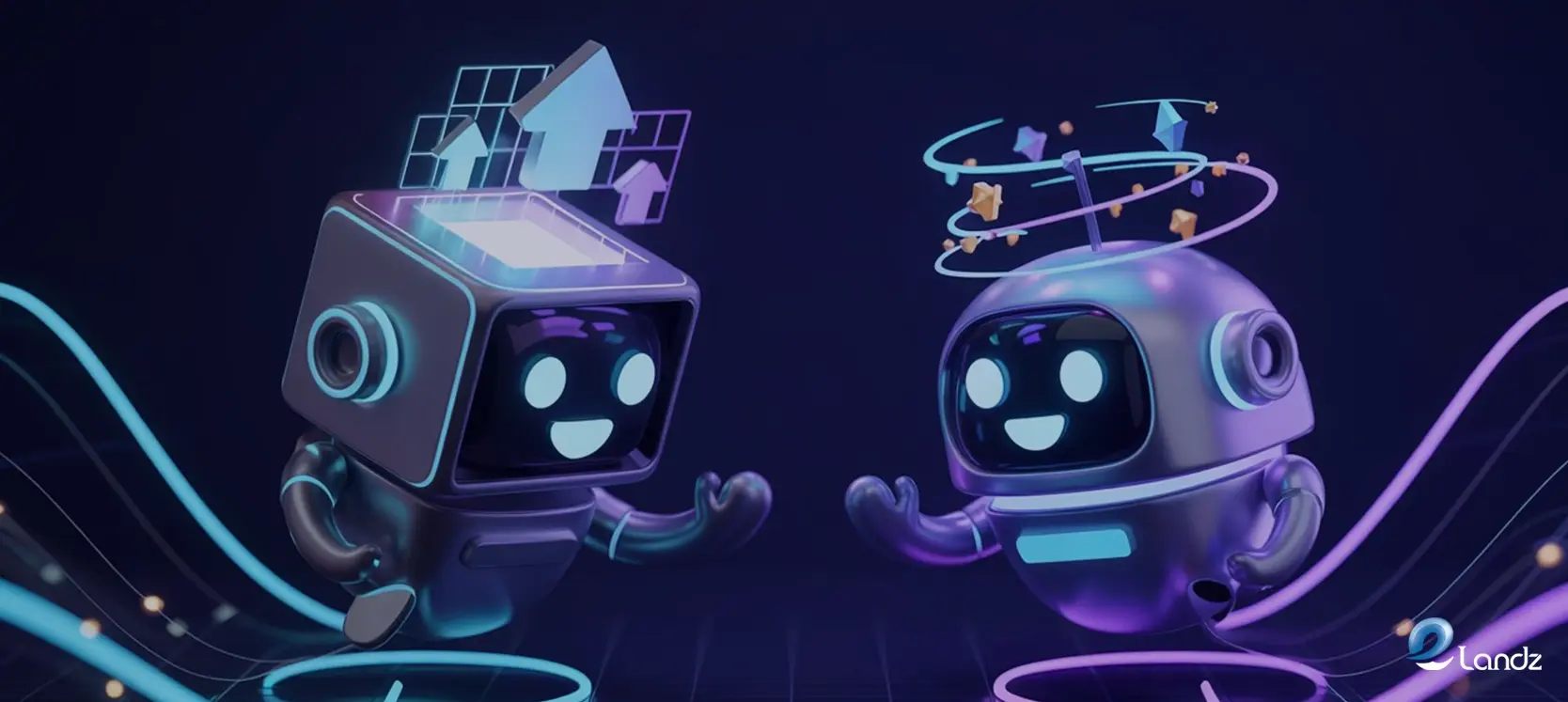
Agentic AI vs Generative AI: Understanding Core Differences
02 Oct 2025Introduction
Artificial intelligence has been changing how we work and live. Two important types of AI are being talked about everywhere: generative AI and agentic AI. These technologies are different in how they work and what they can do. Understanding these differences is important for anyone who wants to use AI effectively.
What is Generative AI?
Generative AI is designed to create new content. It can make text, images, music, videos, and computer code. This type of AI learns from existing information and uses that knowledge to produce original outputs that look like they were made by humans.
Popular tools like ChatGPT, DALL-E, and MidJourney have been adopted by millions of users. These systems use advanced computer networks called neural networks. They analyze patterns in training data and attempt to replicate those patterns when creating new content.
Recent data shows that generative AI adoption jumped from 55% to 75% between 2023 to 2024.
Key Features of Generative AI
Several important characteristics define how generative AI works:
Pattern Recognition and Copying
Generative AI is good at finding patterns in training data and creating variations of those patterns. Whether it’s writing poems like Shakespeare or creating website code, it builds on learned patterns to make something new.
Needs Human Input
Every action by generative AI starts with a human asking for something. Without someone giving it instructions or prompts, these systems just sit there waiting. They cannot start working on their own.
Focus on Creating Content
The main purpose is to make new content, not to make decisions or take actions. The AI creates things like articles, pictures, or code based on what users ask for.
One-Time Interactions
Most generative AI works in simple back-and-forth exchanges. A person asks a question and gets an answer. They request an image and receive an image. Each interaction stands alone and doesn’t connect to previous conversations.
What is Agentic AI?
Agentic AI systems can make decisions independently, take actions, and work toward goals without requiring constant human supervision. While generative AI creates content, agentic AI creates results and outcomes.
Think of agentic AI as a digital worker that can handle complex tasks from start to finish. It doesn’t just respond to requests; it develops plans, executes those plans, and adapts when situations change. This technology can operate continuously without interruption and handle multiple complex tasks simultaneously.
The main difference is in the thinking approach. Generative AI asks, “What should I create based on this request?” Agentic AI asks, “What actions should I take to reach this goal?” This action-focused mindset turns AI from a tool into a team member that can work independently.
Core Components of Agentic AI
According to Gartner projections, at least 15% of work decisions will be made autonomously by agentic AI by 2028, compared to 0% in 2024. This is due to several important features:
Goal Persistence
Unlike generative AI, which forgets previous interactions, agentic AI remembers objectives over time. When given a goal, it keeps working toward that goal through multiple steps and decisions, even if the process takes hours, days, or weeks.
Environmental Awareness
Agentic AI can sense and respond to its surroundings. In software testing, this means understanding how applications work, recognizing when things change, and adjusting test strategies accordingly.
Tool Integration
These systems don’t just make suggestions; they actually do things through connected tools and programs. They can modify databases, start workflows, and interact with multiple systems at the same time.
Learning from Results
Agentic AI learns from what happens when it takes actions. Failed attempts help inform future strategies. Successful patterns become part of its operational knowledge for next time.
Core Differences Between Agentic AI vs Generative AI

The fundamental distinctions between agentic and generative AI shape their practical applications and determine which technology best fits specific business needs.
Purpose and Function
Generative AI exists to create new content. Its main job is to produce things that didn’t exist before. Whether writing emails, creating marketing materials, making images, or writing code, generative AI turns ideas into actual outputs. The value comes from helping humans produce more content faster and with higher quality.
Agentic AI exists to achieve goals. Its main purpose goes beyond creating content to actually accomplishing objectives through independent action. Rather than waiting for instructions, agentic AI identifies opportunities, makes decisions, and executes strategies to reach defined goals.
Autonomy and Decision Making
Generative AI works in a reactive mode. Every action requires human initiation through prompts or questions. Even the most advanced language models remain inactive without human interaction. They cannot independently identify problems, start conversations, or decide when their capabilities might be useful.
Agentic AI flips this relationship. Given objectives and constraints, it operates with real independence. It identifies when action is needed, determines appropriate responses, executes decisions, and evaluates outcomes without constant human intervention.
Workflow and Functionality
Generative AI excels at separate tasks with defined inputs and outputs. Ask a question, receive an answer. Request an image, get an image. Each interaction exists independently, with no persistent memory or ongoing objective beyond the immediate request.
Agentic AI thrives in complex, multi-step workflows requiring persistent execution over time. It maintains information across interactions, tracking progress toward objectives and adjusting strategies based on intermediate results. This enables true workflow automation beyond simple task completion.
The planning capability is particularly powerful. Agentic AI doesn’t just execute predefined workflows; it creates execution plans based on objectives and constraints. Given a goal, it determines necessary steps, identifies dependencies, allocates resources, and manages execution through completion.
Generative AI Applications
Generative AI has been adopted in creative and analytical tasks that benefit from human oversight:
Content Creation
Blog posts, social media content, marketing copy, and creative writing all benefit from the language capabilities of generative AI. Writers use tools to overcome creative blocks and scale content production. The AI generates ideas and first drafts that humans can then refine.
Code Generation
GitHub Copilot and Amazon CodeWhisperer assist developers in writing code faster by suggesting completions and generating standard code structures. The AI accelerates development, but programmers must still review and validate all output.
Design and Art
DALL-E, Midjourney, and Stable Diffusion enable non-artists to generate professional-quality images from text descriptions. These tools democratize visual creation by making design accessible to broader audiences.
Data Analysis
Generative AI helps interpret complex datasets, generating insights and visualizations from raw information. Analysts use it to identify patterns and create reports that would take much longer to produce manually.
Customer Support
Chatbots powered by generative AI handle routine inquiries, draft responses, and provide 24/7 availability for basic support needs. They can answer common questions and assist customers with straightforward issues.
Agentic AI Applications
Agentic AI tackles complex, goal-oriented challenges requiring independent operation:
Autonomous Software Testing
Testing platforms use agentic AI to manage entire test lifecycles from test generation through execution and maintenance. The system adapts to application changes without human intervention, continuously ensuring software quality.
Supply Chain Optimization
Agentic AI continuously monitors supply chains, predicting disruptions, adjusting routes, managing inventory, and coordinating with suppliers to maintain optimal flow. It can respond to unexpected events and make adjustments in real-time.
Financial Trading
Financial systems use agentic AI to execute trading strategies, monitor markets, identify opportunities, execute trades, and manage risk automatically. The system can make split-second decisions based on market conditions.
Process Automation
Beyond simple scripting, agentic AI handles complex business processes involving multiple systems, exception handling, and dynamic decision-making. It can manage workflows that span different departments and systems.
Predictive Maintenance
Industrial agentic AI monitors equipment, predicts failures, schedules maintenance, orders parts, and coordinates repairs to minimize downtime. It can prevent problems before they occur.
Generative AI Limitations
Every AI technology comes with specific challenges and risks that must be understood before implementation.
Accuracy Issues
Generative AI sometimes produces confident but incorrect outputs. Without fact-checking mechanisms, it can generate believable misinformation. Users must verify important information produced by these systems.
Context Limitations
Limited context windows restrict generative AI’s ability to process extensive information or maintain long conversations coherently. It may lose track of earlier parts of long conversations.
No Verification Ability
Generative AI cannot verify its outputs against reality. It might generate syntactically correct but logically flawed code or factually incorrect content. Human review remains essential.
Prompt Dependency
Output quality heavily depends on how well users write their prompts. Poorly constructed requests yield poor results, requiring users to learn effective prompting techniques.
Agentic AI Considerations
Mistakes by agentic AI can spread through systems before detection. An error in judgment might trigger multiple downstream actions, potentially causing widespread problems.
Unclear objectives may cause agentic AI to pursue goals through unexpected or even detrimental methods. The system may optimize for metrics that do not accurately reflect true intentions.
Systems with execution capabilities present larger attack surfaces. Compromised agentic AI could execute malicious actions across integrated systems, potentially causing significant damage.
Determining responsibility for autonomous decisions becomes complex when AI operates independently.
The Future of AI

The future isn’t about choosing between generative AI or agentic AI; it’s about intelligently combining both. Organizations are beginning to see how these two approaches can work together to create more powerful solutions.
Generative Frontend, Agentic Backend
Systems use generative AI for user interaction and content creation, while agentic AI handles execution and automation. Chatbots that can both answer questions and execute actions represent this pattern.
Coordinated Systems
Agentic AI coordinates multiple generative AI tools to achieve complex objectives. An agentic system might use different models for text generation, image creation, and code writing to build complete solutions.
Feedback Loops
Agentic AI assesses the output from generative AI, choosing, polishing, or recreating content based on defined quality standards. This process results in self-improving systems that continuously raise the quality of the final output..
Conclusion
nderstanding the differences between agentic AI vs generative AI is crucial for making informed decisions about AI adoption. Generative AI excels at content creation and creative tasks that benefit from human oversight. Agentic AI thrives in autonomous operation and complex workflow management.
Both technologies offer significant value, but they serve different purposes. The most successful organizations will likely adopt hybrid approaches that leverage both technologies’ strengths.
As these technologies continue to evolve, their capabilities will expand and their applications will multiply. The key is understanding what each type does best and using them appropriately to maximize their benefits while minimizing their limitations.
FAQs
Check out this FAQ section!
What is the main difference between agentic AI and generative AI?
The main difference lies in their primary functions. Generative AI is designed to create content like text, images, or code based on human prompts. Agentic AI is designed to achieve goals through autonomous decision-making and action-taking without constant human supervision. Generative AI responds to input, while agentic AI proactively works toward objectives.
Can generative AI work without human input?
No, generative AI cannot work without human input. It requires prompts, questions, or instructions from humans to start any task. Every interaction begins with human initiation, and the AI responds to that input. Without human guidance, generative AI systems remain inactive and cannot independently identify when their capabilities might be useful.
How do agentic AI vs generative AI differ in terms of autonomy?
Agentic AI operates with high autonomy and can make decisions, execute actions, and adapt to changing situations without constant human supervision. It can pursue long-term goals through multiple steps and interactions. Generative AI has low autonomy and requires human direction for each task. It cannot maintain objectives across time or make independent decisions about what to do next.
Which type of AI is better for business automation?
Agentic AI is generally better for business automation because it can handle complex, multi-step processes independently. It can monitor systems, make decisions, coordinate different tools, and adapt to changing conditions without human intervention. Generative AI is better for content creation tasks within automated workflows, but requires human coordination.
Are agentic AI and generative AI used together?
Yes, agentic AI and generative AI are often used together in hybrid systems. Agentic AI can coordinate and use generative AI tools as part of achieving larger objectives. For example, an agentic system might use generative AI to create content, draft communications, or generate reports while autonomously managing the overall workflow and decision-making process.



